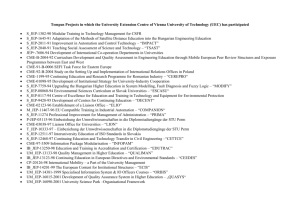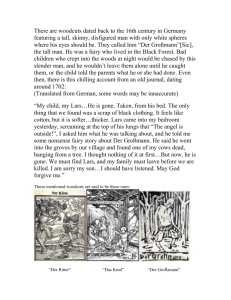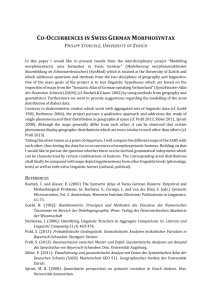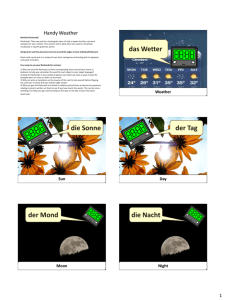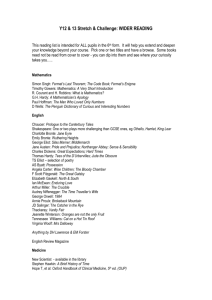Introduction
advertisement
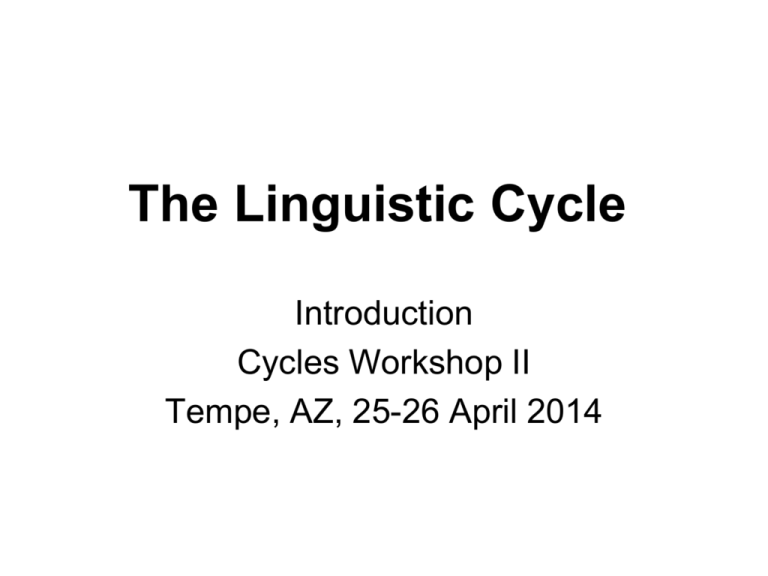
The Linguistic Cycle Introduction Cycles Workshop II Tempe, AZ, 25-26 April 2014 Outline A. Why look at Cycles? B. Some background C. Examples of Linguistic Cycles D. Possible explanations Cycles are a window on the Faculty of Language Reanalysis shows: loss of features Cycle or Spiral: von der Gabelentz 1901 Nun bewegt sich die Geschichte der Sprachen in der Diagonale zweier Kräfte: des Bequemlichkeitstriebes, der zur Abnutzung der Laute führt, und des Deutlichkeitstriebes, der jene Abnutzung nicht zur Zerstörung der Sprache ausarten lässt. Die Affixe verschleifen sich, verschwinden am Ende spurlos; ihre Funktionen aber oder ähnliche drängen wieder nach Ausdruck. ctd Diesen Ausdruck erhalten sie, nach der Methode der isolierenden Sprachen, durch Wortstellung oder verdeutlichende Wörter. Letztere unterliegen wiederum mit der Zeit dem Agglutinationsprozesse, dem Verschliffe und Schwunde, und derweile bereitet sich für das Verderbende neuer Ersatz vor ... ; immer gilt das Gleiche: die Entwicklungslinie krümmt sich zurück nach der Seite der Isolation, nicht in die alte Bahn, sondern in eine annähernd parallele. Darum vergleiche ich sie der Spirale. (von der Gabelentz 1901: 256) The history of language moves in the diagonal of two forces: the impulse toward comfort, which leads to the wearing down of sounds, and that toward clarity, which disallows this erosion and the destruction of the language. The affixes grind themselves down, disappear without a trace; their functions or similar ones, however, require new expression. They acquire this expression, by the method of isolating languages, through word order or clarifying words. The latter, in the course of time, undergo agglutination, erosion, and in the mean time renewal is prepared: periphrastic expressions are preferred ... always the same: the development curves back towards isolation, not in the old way, but in a parallel fashion. That's why I compare them to spirals. Comfort + Clarity = Grammaticalization + Renewal Von der Gabelentz’ examples of comfort: the unclear pronunciation of everyday expressions, the use of a few words instead of a full sentence, i.e. ellipsis (p. 182-184), “syntaktische Nachlässigkeiten aller Art” (`syntactic carelessness of all kinds’, p. 184), and loss of gender. Von der G’s examples of clarity special exertion of the speech organs (p. 183), “Wiederholung” (`repetition’, p. 239), periphrastic expressions (p. 239), replacing words like sehr `very’ by more powerful and specific words such as riesig `gigantic’ and schrecklich `frightful’ (243), using a rhetorical question instead of a regular proposition, and replacing case with prepositions (p. 183). Grammaticalization = one step Hopper & Traugott 2003: content item > grammatical word > clitic > inflectional affix. The loss in phonological content is not a necessary consequence of the loss of semantic content (see Kiparsky 2011; Kiparsky & Condoravdi 2006; Hoeksema 2009). It can come from either phonological weakening triggering semantic strengthening or the other way round. Renewal is the other step In acknowledging weakening of pronunciation (“un affaiblissement de la pronunciation”), Meillet (1912: 139) writes that what provokes the start of the (negative) cycle is the need to speak forcefully (“le besoin de parler avec force”). Kiparsky & Condoravdi (2006) similarly suggest pragmatic and semantic reasons. A simple negative cannot be emphatic; in order for a negative to be emphatic, it needs to be reinforced, e.g. by a minimizer. Macrocycles and microcycles Heine, Claudi & Hünnemeyer’s (1991: 245) distinguish different kinds of cycles: grammaticalization, changes in subparts, e.g. the TMA system, and entire language type changes. I refer to these as micro and macrocycles. A microcyle involves just one aspect of the language, for instance, negatives or demonstratives being reinforced by adverbs, as in English those people there. They include Heine et al’s first and second kind. Microcycles (1)a. I’m gonna leave for the summer. b. *I’m gonna to Flagstaff for the summer. Nesselhauf (2012) identifies three features, intention, prediction, and arrangement, in the change of shall, will, ‘ll, be going to, be to, and the progressive) in the last 250 years: as the sense of intention is lost and replaced by the sense of prediction, new markers of intention will appear: want has intention in (4a) and it is starting to gain the sense of prediction, as in (4b). (2)a. The final injury I want to talk about is brain damage ... (Nesselhauf 2012: 114). b. We have an overcast day today that looks like it wants to rain. (Nesselhauf 2012: 115). Modal and degree cycles Remus Gergel: Modal, degree, and rather Lukasz Jedrzejowski Verbs to modals in succession And degree in the DP: Johanna Wood such and so Macrocycles Hodge (1971): Proto-Afroasiatic analytic *Sm Old Egyptian synthetic sM Late Egyptian analytic Sm Coptic synthetic sM Huang (to appear): Chinese, from moderately synthetic to analytic to moderately synthetic. Now on to four cycles: Negative Cycles (Jespersen 1917, Dahl 1979, Croft 1991, van der Auwera 2009 etc) I Indefinite phrase > negative = Jespersen’s Cycle Negation weakens and is renewed. For instance: (1) I cannot do that > (2) I ca(n’t) see nothing II Verb > negative (3) is-i ba-d-o Koorete she-NOM disappear-PF-PST `She disappeared' (Binyam 2007: 7). (4) ‘is-i dana ‘ush-u-wa-nni-ko she-NOM beer drink-PRES-not_exist-3FS-FOC ‘She does (will) not drink beer.’ (Binyam 2007: 9). Negative Cycle in Old English 450-1150 CE a. no/ne early Old English b. ne after 900, esp S c. (ne) not d. not > (na wiht/not) after 1350 -not/-n’t after 1400 Indefinite Negative Cycle, e.g. English, French, Arabic XP Spec na wiht X' X not > n’t YP … Negative source is a verb (1) wo mei you shu Chinese I not exist book `I don't have a book.’ (2) Yao Shun ji mo ... Old Chinese Yao Shun since died `Since Yao and Shun died, ...' (Mengzi, Tengwengong B, from Lin 2002: 5) (3)yu de wang ren mei kunan, ... Early Mandarin wish PRT died person not-be suffering `If you wish that the deceased one has no suffering, ...' (Dunhuang Bianwen, from Lin 2002: 5-6) According to Lin, mei went through a perfective stage, so: (4) dayi ye mei you chuan, jiu zou le chulai coat even not PF wear, then walk PF out `He didn't even put on his coat and walked out.' (Rulin Waishi, from Lin 2002: 8) (5) NegP Neg mei ASPP ASP mei VP V mei ... Three presentations on Neg Cycles Ljuba Veselinova: neg existential> neg Johan vd Auwera & Frens Vossen: word order, multiple negatives, and more Clifton Pye: triggering the cycle The Subject Cycle A. demonstrative > third person pron > clitic > agreement B. oblique/noun > first/second pron > clitic > agreement Givón (1976, etc), Mithun (1991, etc) have provided much insight into this and we’ll hear more from them today! Brazilian Portuguese (1) Vossa mercê > Vosmecê > (V)ocê > cê your favor/mercy you you-INDEF (see Mattoso Câmara 1979; Gonçalves 1987; Dutra 1991, cited in Vitral & Ramos 2006) (2) cê only in subject position and pre-V English: in transition? (a) Modification, (b) coordination, (c) position, (d) doubling, (e) loss of V-movement, (f) Code switching Coordination (and Case) (1) Me and Kitty were to spend the day. (2) %while he and she went across the hall. Position (3) She’s very good, though I perhaps I shouldn’t say so. (4) You maybe you've done it but have forgotten. (5) Me, I was flying economy, but the plane, … was guzzling gas Doubling and cliticization (1) (2) (3) (4) Me, I've tucking had it with the small place. (BNC H0M 1608) %Him, he .... %Her, she shouldn’t do that (not attested in the BNC) *A dog, it should be happy. CSE-FAC: uncliticized I 2037 you 1176 he 128 cliticized 685 (=25%) 162 (=12.1%) 19 (=12.9%) total 2722 1338 147 Problem in English: why so slow! Loss of V-movement and Code switching (5) (6) (7) (8) What I'm gonna do? `What am I going to do' How she's doing? `How is she doing‘ *He ging weg `he went away’ Dutch-English CS The neighbor ging weg Subject Cycle, structurally Full phrase moves to Spec TP > Head moves to T Reanalysis as to what the head is: pronoun or agreement. (Economy: agreement =uninterpretable and then this needs an interpretable feature as well) Copula cycle, sources • Verbs • Demonstratives • Prepositions etc Reanalysis of location, identity, and aspect features. The flavors in e.g. English are be, become, go, fall, turn, seem, appear, stay, and remain. Indo-European > English No difference in NP, PP predicate (but inside the paradigm: *es (< Dem) *bheu `grow’ > Latin fui > Old English `be, become’ *wes `remain, dwell’ *sta > estar (Spanish), tha (Hindi), tá (Irish) *wert ‘turn’ > vartate (Sanskrit), wairþan (Gothic), and weorðan (OE) Old Egyptian (1) > Middle (2) (1) (2) (3) a. rmt p-n man MS-PROX `this man.’ b. ntr-w jp-w god-P MP-DIST `those gods.’ ̩tmj-t pw jmn-t city-F be west-F `The West is a city.’ (Loprieno 1995; 2001) p -w > pw [i-3MS] [distal] [loc] [u-phi] Identification/classification vs location Saramaccan equative – identificational da class membership da/dɛ locative dɛ (McWhorter 2005: 117-8; 171) NigerianPidgin be/na (Mazzoli 2013: 91) - de Demonstrative and adverbial source of copulas (1) a. Mi da i tatá Saramaccan I am your father ‘I am your father.’ (McWhorter 1997: 87) b. Hεn dà dí Gaamá he is the chief ‘He's the chief.’ (McWhorter 1997: 98) (2) Dí wómi dε a wósu the woman is at house `The woman is at home.’ (McWhorter 1997: 88) Demonstrative to article cycle (1) demonstrative/adverb > definite article > Case/non-generic > class marker > 0 (2) gife to … þa munecas of þe mynstre give to … the monks of the abbey (Peterborough Chron. 656) (3) * the Demonstratives, pronouns, and pro-drop in Old English (1) þæt fram ham gefrægn Higelaces þegn, god mid Geatum, Grendles dæda; se wæs moncynnes mægenes strengest on þæm dæge þysses lifes, æþele ond eacen. `Hygelac’s thane heard about Grendel’s deeds while in Geatland; he (=Hygelac’s thane) was mankind’s strongest man on earth, noble and powerful. Old English ctd Het him yðlidan godne gegyrwan, cwæð, he guðcyning ofer swanrade secean wolde, mærne þeoden, þa him wæs manna þearf. ðone siðfæt him snotere ceorlas lythwon logon, þeah he him leof wære. (He) ordered himself a good boat prepared and said that he wanted to seek the king over the sea since he (=the king) needed men. Wise men did not stop him (=Hygelac’s thane) though he was dear to them.’ (Beowulf 194-98) Around 1200: a reanalysis (1) & gaddresst swa þe clene corn `and so you gather the clear wheat.’ (Ormulum 1484-5, Holt edition) (2) 3ho wass … Elysabæþ 3ehatenn `She was called Elisabeth.’ (Ormulum 115) (3) & swa þe33 leddenn heore lif Till þatt te33 wærenn alde `and so they led their lives until they were old.’ (Ormulum 125-6) (4) þin forrme win iss swiþe god, þin lattre win iss bettre. `Your earlier wine is very good, your later wine is better.’ (Ormulum 15409) Reduction of the article and renewal (3) Morret's brother came out of Scoteland for th'acceptacion of the peax (The Diary of Edward VI, 1550s) (4) Oh they used to be ever so funny houses you know and in them days … They used to have big windows, but they used to a all be them there little tiny ones like that. (BNC - FYD 72) What happens? Externally: a `strengthening’ of the third person features in the pronoun and a shift in the relationship with the demonstrative. This reinforcement through external pronouns, she and they, brought about a reanalysis of the features of the pronoun as deictic. Demonstrative [i-phi]/ [i-loc] article [u-phi] Dem C copula [i-phi] [u/i-T] [u-phi] [i-loc] [i-loc] Also: degree adverb and tense marker (TibetoBurman) Feature Economy: Utilize semantic features: use them as for functional categories, i.e. as formal features. Generative Grammar of the1990s-2013 Parameters consist of choices of feature specifications as the child acquires a lexicon (Chomsky 2004; 2007). Baker, while disagreeing with this view of parameters, calls this the Borer-ChomskyConjecture (2008: 156): "All parameters of variation are attributable to differences in the features of particular items (e.g., the functional heads) in the lexicon." The importance of features Chomsky (1965: 87-88): lexicon contains information for the phonological, semantic, and syntactic component. Sincerity +N, -Count, +Abstract...) Chomsky (1995: 230ff; 236; 277ff): semantic (e.g. abstract object), phonological (e.g. the sounds), and formal features: intrinsic or optional. Semantic and formal overlap: Chomsky (1995: 230; 381) suggests: "formal features have semantic correlates and reflect semantic properties (accusative Case and transitivity, for example)." I interpret this: If a language has nouns with semantic phi-features, the learner will be able to hypothesize uninterpretable features on another F (and will be able to bundle them there). Summary Cycle – Spiral Micro-Macro Cycles Four examples Explanation in terms of features but many others as we’ll see next!


